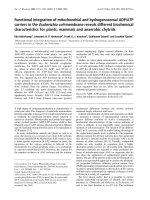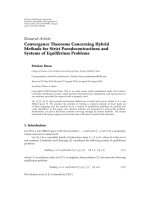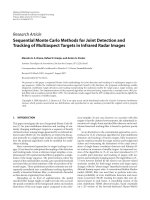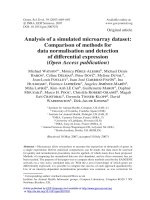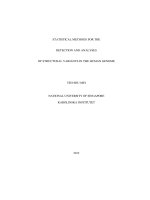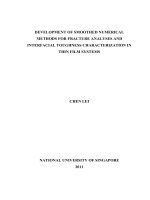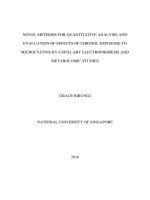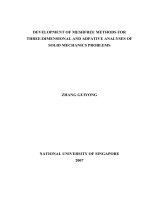Evaluation of different establishment methods for enhancing productivity and profitability of rice under puddle condition
Bạn đang xem bản rút gọn của tài liệu. Xem và tải ngay bản đầy đủ của tài liệu tại đây (141.44 KB, 6 trang )
Int.J.Curr.Microbiol.App.Sci (2018) 7(8): 3340-3345
International Journal of Current Microbiology and Applied Sciences
ISSN: 2319-7706 Volume 7 Number 08 (2018)
Journal homepage:
Original Research Article
/>
Evaluation of Different Establishment Methods for Enhancing Productivity
and Profitability of Rice under Puddle Condition
M. Mali*, M. Kumar, P.K. Salam, G.K. Sharma and R.R. Saxena
SGCARS, Jagdalpur (IGKV, Raipur), India
*Corresponding author
ABSTRACT
Keywords
Rice establishment
methods and yield
attributes and grain
yield.
Article Info
Accepted:
20 July 2018
Available Online:
10 August 2018
A field experiment conducted during Kharif season of 2017 under AICRIP,
in Alfisols at Instructional cum Research of Shaheed Gundadhoor College
and Agricultural Research Station, Jagdalpur, Chhattisgarh, to study grain
yield of rice as influenced by different establishment methods under puddle
condition. Results indicated that highest grain yield (q ha -1) was registered
under the treatment line transplanting method (T1) which was at par with
treatment wet direct seeded rice using drum seeder (T3). The lowest grain
yield (q ha-1) was recorded with treatment dry direct sowing method (T5).
Introduction
Rice is a member of the family Poaceae
originated from South-East Asia. In world rice
has occupied an area of 158.9 million
hectares, with a total production of 685.0
million tonnes in 2011 (Anonymous, 2016). In
Asian countries, rice is the main major staple
crop covering about 90% of rice grown in the
world, thus rice is immensely important to
food security of Asia. Rice (Oryza sativa L.) is
considered as the „Global Grain‟ in 89 nations
and it is an important food for more than half
of the global population. In India, rice is
grown under three major ecosystem: rainfed
upland (16%), irrigated land (45%) and
rainfed lowland (39%), with a productivity of
0.87, 2.24, and 1.55 t ha-1, respectively. The
slogan „Rice is life‟ is most appropriate for
India. It contributes 20 to 25 per cent of
agriculture GDP.
Method of establishment is one of the cultural
practices, which influences the rice crop
through its effect on growth and development
(Gobi et al., 2006).Transplanting of rice
seedlings in the traditional way is a laborious,
time consuming and causes drudgery. Nonavailability of labors for transplanting at
appropriate time leads to late planting, which
results in poor yields. Rice transplanting is
3340
Int.J.Curr.Microbiol.App.Sci (2018) 7(8): 3340-3345
done manually and requires about 306 man-h
ha-1, which is roughly 42 % of the total labor
requirement
of
rice
production.
Balasubramanian and Hill (2002) stated that
direct seeding could be alternative to the
traditional transplanting culture but poor
germination, uneven crop stands and high
weed infestation are among the main
constraints to the adoption of direct seeded
rice. Direct seed rice refers to the process of
establishing a rice crop from seeds sown in the
field rather than by transplanting seedlings
from nursery (Farooq et al., 2011).
which parentage are Mahamaya x NSN 5
(MTC-4, IET 11904), maturity duration 130135 days, grain type long slender grain. The
crop was established 27.06.17 and harvested
on 06.11.17. The soil of the experimental site
is characterized as silty loam (fairly leveled).
The soil was locally known as Mal (Alfisols).
It is well fertile soil belongs to mid land
situation of landscape in Jagdalpur. During
kharif 2017, a total of 1602.9 mm rainfall in
82 rainy days was recorded against the normal
rainfall of 1195 mm.
Results and Discussion
There are three principal methods of DSR: dry
seeding (sowing dry seeds into dry soil), wet
seeding (sowing pre-germinated seeds into dry
soil) and water seeding (seeds sown into
standing water). Wet seeding is sowing of pre
germinated seed on to puddled soil which is a
major crop establishment system of rice
culture in Chhattisgarh and also used in other
parts of the tropics and subtropics. This
method also became mandatory in case of
continuous rains, where direct dry seeding,
nursery raising is not possible or in delayed
condition.
Plant height, dry matter accumulation leaf
area index, root volume and root dry
weight at different durations of rice as
influenced by different crop establishment
methods
The plant height at different intervals
significantly affected due to the different
establishment methods (Table 1). At most of
stages taller plant observed under treatment
line transplanting (T1). However, at 90 DAE
and harvest which was at par with treatment
wet direct seeded rice using drum seeder (T3).
Materials and Methods
Research trial on “Evaluation of different
establishment
methods
for
enhancing
productivity and profitability of rice under
puddle condition” was conducted at
Instructional cum Research Farm, Shaheed
Gundadhoor College of Agricultural and
Research Station, Jagdalpur, Chhattisgarh
during kharif season of 2017. The experiment
was laid out in randomized block design with
four replications. The different methods of
establishment viz., line transplanting (T1),
random transplanting (T2), wet direct seeded
rice using drum seeders (T3), wet direct seeded
rice by broadcasting (T4) and direct sowing
method (Dry seeded) (T5)were adopted.
The variety Durgeswari was taken as a test
Plant height is an important morphological
attribute. It is a function of combined effects of
genetic make up of a plant, soil nutrient status,
seedling vigor and the environmental
conditions in which it is grown.
At all the growth periods of observations
treatment (T1) line transplanting method
recorded significantly highest dry matter
accumulation. However, during 30 and 90
DAE treatment line transplanting method (T1)
which was at par with treatment wet direct
seeded rice using drum seeder (T3) with an
additional treatment (T2) random transplanting
method at 30 DAE. In general the leaf area
index showed increasing trend from 30 DAE
to 90DAE whereas at harvest stage slightly
3341
Int.J.Curr.Microbiol.App.Sci (2018) 7(8): 3340-3345
decreases in all establishment methods. At all
growth stages treatment line transplanting
method (T1) recorded significantly higher leaf
area index but at 60 and 90 DAE which was at
par with treatment wet direct seeded rice using
drum seeder (T3).
Further, at harvest stage it was found to be non
significant. Significantly highest root volume
was registered under treatment line
transplanting method (T1) at all recorded
durations and superior to other treatments
except at harvest which was at par with
treatments random transplanting (T2) and wet
direct seeded rice using drum seeder (T3).
The establishment method under treatment
line transplanting (T1) registered significantly
highest root dry weight at all growth stages
except 60 and 90 DAE in which at par with
treatment random transplanting (T2). Plant
height depicts health and vigor of a crop. It is
directly proportional with the development of
root system and availability of nutrients to the
plants (Table 2). Hussain et al., (2013) stated
highest plant heights were recorded in
transplanted crop in puddled soil (123.7 cm)
whereas the lowest plant height was observed
in direct seeded crop.
The dry matter accumulation is the function of
number of tillers and leaves, plant height and
tillers panicle weight. The release of nutrients
while application and its absorption,
translocation and conversion of energy for
growing parts helped to increase the dry
matter accumulation.
These results corroborate with reported by
Belder et al., (2005) leaf area index (LAI) is
an important parameter of rice canopy because
it is directly and positively related to crop
photosynthesis. Zhong et al., (2002) revealed
that LAI and plant N status are two major
factors that influence tiller production in rice
crops.
Number of effective tillers, 50 % flowering,
no of panicle, panicle length, grains panicle1
and Panicle weight at different durations
of rice as influenced by different crop
establishment methods
Significantly highest days taken to 50 %
flowering was recorded under treatment wet
direct seeded rice using drum seeder (T3)
which was at par with treatment wet direct
seeded rice by broadcasting (T4). The
treatment dry direct sowing method (T5)
flowers 50 % earlier than rest of the treatments
(Table 4). Significantly highest number of
effective tillers hill-1 was obtained with
treatment line transplanting (T1) and superior
over rest of the treatments. Tillering plays an
important role in determining rice grain yield
since it is closely related to panicle number
per unit ground area. Significantly longest
panicle was registered with treatment line
transplanting method (T1) which was at par
with treatment wet direct seeded rice using
drum seeder (T3). The shortest panicle was
observed under treatment dry direct sowing
method (T5). Goel and Verma (2000) found
higher panicle length from the transplanting
method than the direct sowing method.
Significantly highest number of panicle hill -1
was
registered
with
treatment
line
transplanting method (T1) which was at par
with treatment wet direct seeded rice using
drum seeder (T3). The lowest number of
panicle hill-1 was observed under treatment dry
direct sowing method (T5). Significantly
highest number of grains panicle-1 was
registered under the treatment random
transplanting method which was at par with
treatment wet direct seeded rice using drum
seeder (T3), line transplanting method (T1) and
wet direct seeded rice by broadcasting (T4).
The significantly highest Panicle weight (g)
was registered under the treatment line
transplanting method (T1) which was at par
with treatment random transplanting (T2) and
wet direct seeded rice using drum seeder (T3)
(Table 4). The lowest panicle weight was
3342
Int.J.Curr.Microbiol.App.Sci (2018) 7(8): 3340-3345
recorded with treatment dry direct sowing
method (T5). Rajkhowa and Gogoi (2004)
found more productive tillers in transplanting
of seedlings than sprouted seeds.
Chlorophyll mg gm-1, nutrient content and
nutrient uptake kg ha-1 in grain and straw
of rice as influenced by different crop
establishment methods
The data revealed that crop establishment
methods were found to be non significant
effect on chlorophyll „a‟, „b‟ and total contents
(Table 3). This might be due to all
establishment methods treatments got equal
nutrients. Significantly highest N content in
grain and straw was registered under the
treatment line transplanting method (T1)which
was at par with treatments random
transplanting (T2) and with an additional
treatment wet direct seeded rice using drum
seeder (T3) in straw. While, highest P content
in grain and straw was registered under the
treatment line transplanting method which was
at par with treatments wet direct seeded rice
using drum seeder (T3) and with an additional
treatment random transplanting (T2) in grain.
Significantly highest K content in straw was
registered
under
the
treatment
line
transplanting method (T1) which was at par
with treatment wet direct seeded rice using
drum seeder (T3). Further, grain K content was
found to be non significant. Significantly
highest N, P and K uptake in grain and straw
were recorded under treatment line
transplanting method (T1) which was at par
with treatment wet direct seeded rice using
drum seeder (T3). The lowest N uptake in
grain was observed with treatment dry direct
sowing method (T5). The nitrogen, phosphorus
and potassium efficiencies are accelerated due
to different methods of establisment of rice.
This is in agreement with other studies where
the higher nutrient uptake with treatment line
transplanting method (T1) followed by
treatment wet direct seeded rice using drum
seeder (T3) might be attributed to
solubilization of native nutrients, their
mobilization,
proper
space,light
and
accumulation of different nutrients in different
plant parts.These results are also in agreement
with the findings obtained by Sharma et al.,
(2007).
Test weight, yield, harvest index and
economics of rice as influenced by different
crop establishment methods
The test weight data revealed that
establishment methods found to be non
significant (Table 5). Gill et al., (2008) found
test weight did not differ significantly on
account of method of crop establishment.
The significantly highest grain yield (q ha-1)
was registered under the treatment line
transplanting method (T1) which was at par
with treatment wet direct seeded rice using
drum seeder (T3). The lowest grain yield (q
ha-1) was recorded with treatment dry direct
sowing method (T5).The significantly highest
straw yield (q ha-1) was registered under the
treatment line transplanting method (T1)
which was at par with treatment random
transplanting (T2) and wet direct seeded rice
using drum seeder (T3). The lowest straw yield
notice under treatment dry direct sowing
method (T5). The data revealed that harvest
index of rice found to be non significant
(Table 5). Many factors determine the yield
for rice crop during cultivation such as soil,
cultivar, season, environment, planting time,
methods of establishment, water management,
weed control, cropping pattern, source, form,
rate, time of application and method of
application. Mankotia et al., (2009) found
similar results that among four methods of rice
establishment transplanted method of paddy
resulted in significantly higher grain yield
(3.98 t ha-1) followed by drum seeding(3.37 t
ha-1), broadcast seeding(3.27 t ha-1) of
sprouted seeds and row seeding (2.95 t ha-1) in
3343
Int.J.Curr.Microbiol.App.Sci (2018) 7(8): 3340-3345
prepared bed. Significantly highest gross
return was registered with treatment line
transplanting method (T1) over rest of the
treatments.
Transplanted flooded rice leads to high losses
of water through puddling, surface
evaporation and percolation. Significantly
highest net return and B: C ratio was
registered with treatment wet direct seeded
rice using drum seeder (T3) over rest of the
treatments. Further, treatment dry direct
sowing method (T5) registered lowest gross,
net and B: C ratio (Table 6). Similar finding
was reported by Rana et al., (2014) higher B:
C cost ratio under direct seeding of sprouted
seed than transplanting methods due to saving
of irrigation water and labour,
In conclusion, the significantly highest grain
yield (q ha-1) was registered under the
treatment line transplanting method (T1)
which was at par with treatment wet direct
seeded rice using drum seeder (T3). The
lowest grain yield (q ha-1) was recorded with
treatment dry direct sowing method (T5).The
significantly highest straw yield (q ha-1) was
registered
under
the
treatment
line
transplanting method (T1) which was at par
with treatment random transplanting (T2) and
wet direct seeded rice using drum seeder
(T3).The lowest straw yield notice under
treatment dry direct sowing method (T5).
highest gross return was registered with
treatment line transplanting method (T1) over
rest of the treatments. Transplanted flooded
rice leads to high losses of water through
puddling, surface evaporation and percolation.
Significantly highest net return and B: C ratio
was registered with treatment wet direct
seeded rice using drum seeder (T3) over rest of
the treatments. Further, treatment dry direct
sowing method (T5) registered lowest gross,
net and B: C ratio.
References
Anonymous.2016. Krishi Darshika, Annual
publication of Directorate of Extension
Services, IGKV, Raipur (C.G.)
Balasubramanian, V. and Hill, J. E. 2002.
Direct seeding of rice in Asia:
Emerging issues and strategic research
needs for the 21st century. In “Direct
Seeding: Research Strategies and
Opportunities” (S. Pandey, M.
Mortimer, L. Wade, T. P. Tuong, K.
Lopez, and B. Hardy, Eds.), pp. 15–39.
International Rice Research Institute,
Los Banos, Philippines.
Belder, P., Bouman, B.A.M., Spiertz, J.H.J.,
Peng, S., Castaneda, A.R. and
Visperas,
R.M.
2005.
Crop
performance, nitrogen and water use in
flooded and aerobic rice. Plant and
Soils, 273: 167-82.
Gobi, R.,Pandian, B.J.and Karaka, S. 2006.
Evaluation of stand establishment
methods and split application of N and
K for hybrid rice (CoRH-2).Crop
Research. 32(3): 275-278.
Gill,M.S., Ashwini,K. and Pardeep, K. 2008.
Growth and yield of rice (Oryza
sativa) cultivars under various methods
and times of sowing. Indian Journal of
Agronomy, 51(2): 123-127.
Goel, A.C. and Verma, K.S. 2000.
Comparative study of direct seeding
and transplanting of rice. Indian J.
Agril. Res. 34(3): 194-196.
Farooq., M, Siddique., K.H.M., Rehman.,H,
A.T., Dong, J. L. and Wahid, A. 2011.
Rice direct seeding: Experiences,
challenges and opportunities. Soil
Tillage Res, 111: 87–98.
Hussain, S., Ramzan, M., Rana, M. A., Mann,
R. A. and Akhter, M. 2013. Effect of
various planting techniques on yield
and yield components of rice. The
Journal
of
Animal
&
Plant
3344
Int.J.Curr.Microbiol.App.Sci (2018) 7(8): 3340-3345
Sciences, 23(2): Page: 672-674.
Mankotia, B.S., Sekhar, J and Negi, S.C.
2009. Effect of crop establishment
techniques on productivity of ricewheat cropping system. Oryza. 46 (3):
205-208.
Rajkhowa, D.J. and Gogoi, A.K. 2004. Effect
of planting methods and weed
management on transplanted summer
rice. Indian J. Weed Sci. 36(1/2): 119121.Sciences, 23(2): 2013, Page: 672674.
Rana, M. M., Mamum, M. A., Zahan, A.,
Ahmed, M. N. and Mridha, M. A. J.
2014. Effect of planting methods on
yield and yield attributes of short
How to cite this article:
duration Aman rice. American Journal
of Plant Sciences. 5: 251-255.
Sharma, R. P., Patha, S.K. and Singh, R.C.
2007. Effect of nitrogen and weed
management practices in direct seeded
rice (Oryza sativa) under upland
conditions.
Indian
Journal
of
Agronomy. 52:114-119.
Zhong, X., Peng, S., Sheehy, J.E., Visperas,
R.M. and Liu, H. 2002. Relationship
between tillering and leaf area index:
quantifying critical leaf area index for
tillering in rice. J. Agric. Sci., 138:
269-279.
Mali, M., M. Kumar, P.K. Salam, G.K. Sharma and Saxena, R.R. 2018. Evaluation of Different
Establishment Methods for Enhancing Productivity and Profitability of Rice under Puddle
Condition. Int.J.Curr.Microbiol.App.Sci. 7(08): 3340-3345.
doi: />
3345
